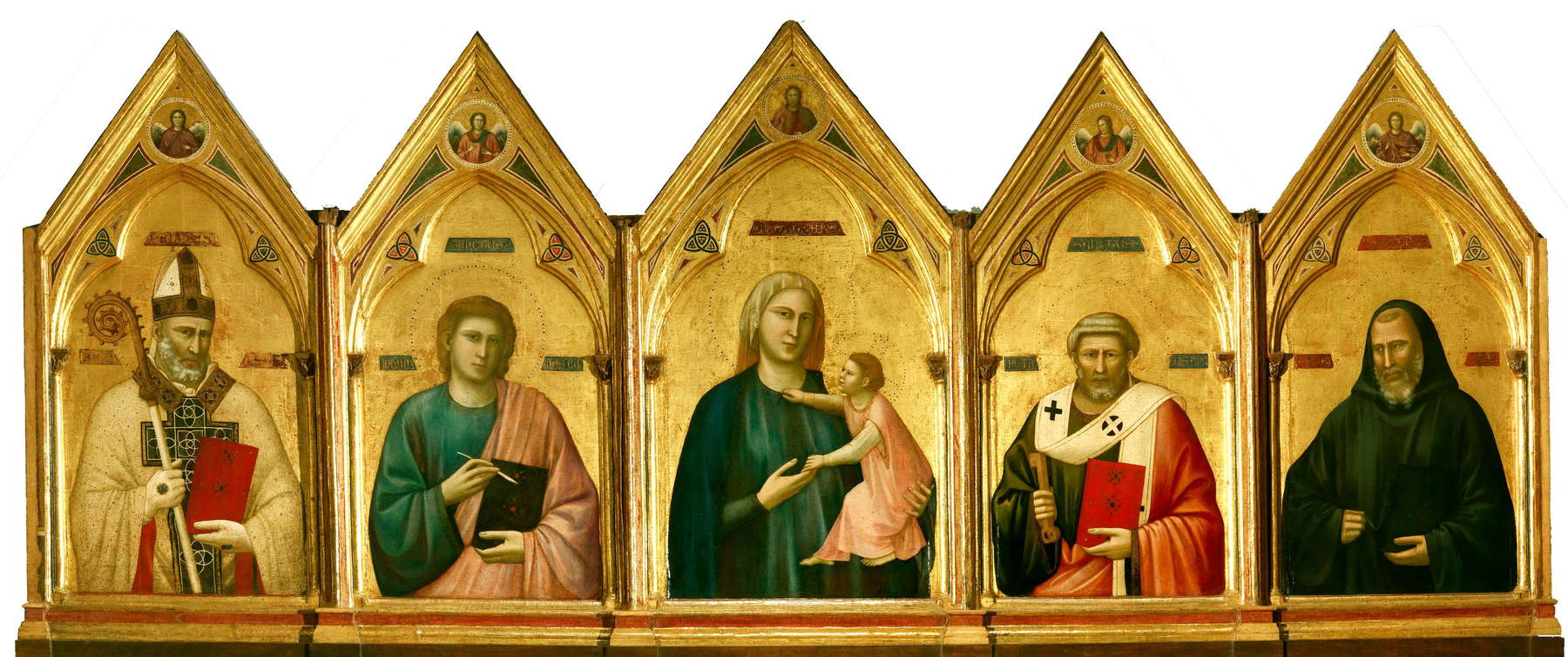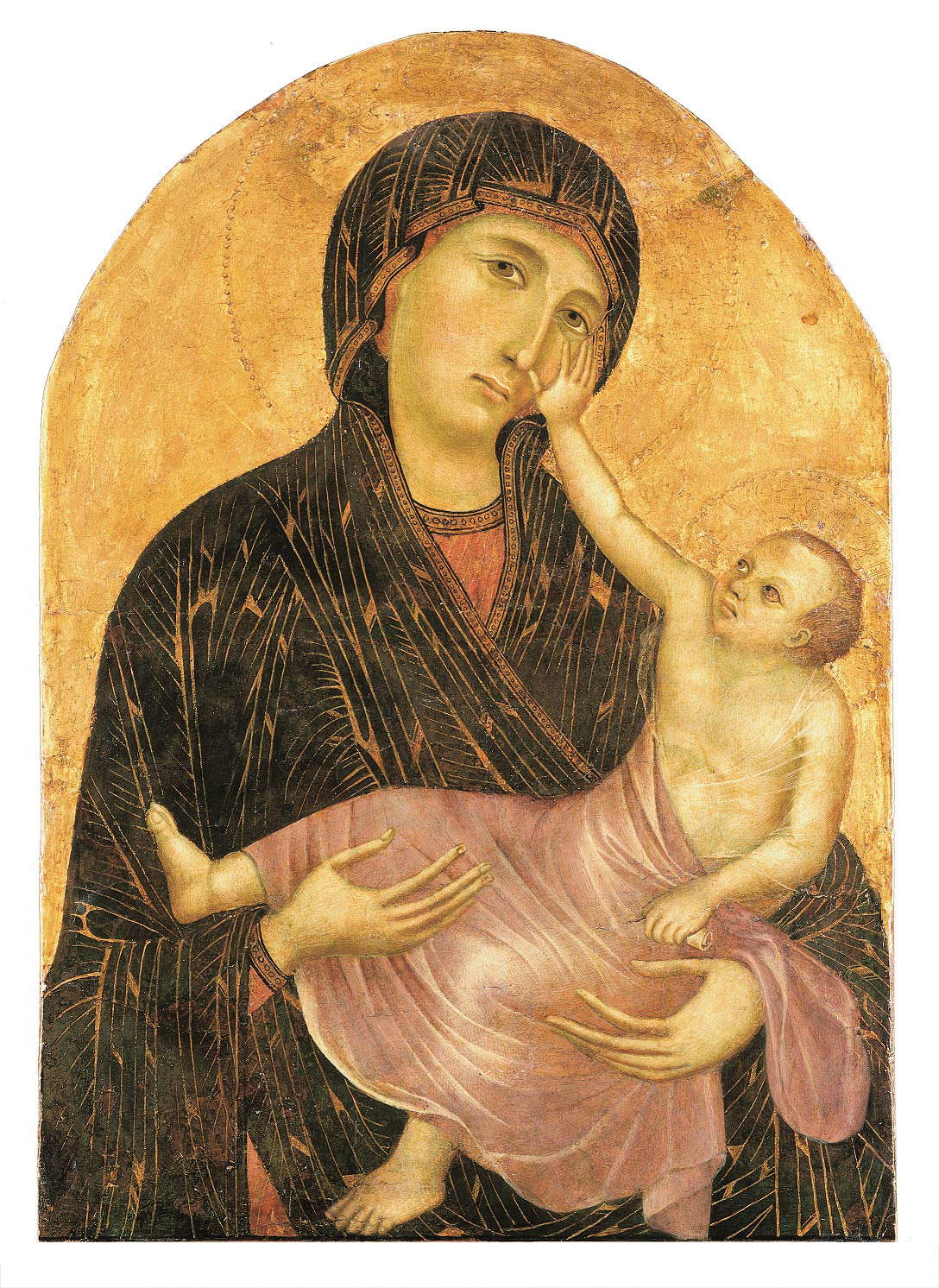In his Florence, Dante Alighieri lived not far from the church of Badia, where one of the great protagonists of the painting scene contemporary to him, Giotto (Florence?, c. 1267 - Florence, 1337), had worked, and it was probably here, before he moved to Rome in October 1301, that he was able to admire the great and innovative polyptych on the high altar, known today as the Badia Polyptych. The two great painters of Florence in the late thirteenth century, when Dante could still witness and participate in the period of full artistic-cultural ferment that the Tuscan city was experiencing, before the beginning of his exile that would remove him forever from his homeland, were Cimabue (Florence, c. 1240 - Pisa, 1302) and Giotto, whom the poet himself mentions in the Purgatory of his Comedy as contenders in “lo campo della pittura.” In fact, in the11th Canto of Purgatory we read, “Credette Cimabue ne la pittura / tener lo campo, e ora ha Giotto il grido, / sì che la fama di colui è scura. / Così ha tolto l’uno a l’altro Guido / la gloria de la lingua; e forse è nato / chi l’uno e l’altro caccerà del nido”: Dante is probably referring here to himself. As Antonio Paolucci wrote, Giotto was a master of a more universal art, one that was able to bring together the entire Italian peninsula, just as Dante was searching in those years for a universal language, the illustrious vernacular, capable of uniting the whole of Italy: an art characterized by the “discovery of the true” and the “certainty of measurable space.” The 14th-century artist and chronicler Cennino Cennini described him as the one who “translated art from Greek into Latin and reduced it to the modern.”
Massimo Medica writes in the catalog of the exhibition he curated, Dante. The Eyes and the Mind. The Arts at the Time of Exile, running until July 4, 2021, in the church of San Romualdo in Ravenna, that the Badia Polyptych is awork of fundamental importance for the genesis of the Gothic polyptych, as well as characterized by an extraordinary pictorial and decorative refinement of the highest level, which can still be enjoyed today thanks to the recent restoration of the painting. Examples of this refinement are the nimbuses, engraved freehand. This is an extremely innovative masterpiece for its time, especially with regard to the illusion that the structure of the polyptych itself creates in the observer: it turns out in fact to be divided by five polylobate arches from which the five half-figures represented in their “plastic monumentality” overlook, as in a sort of loggia. The latter, characterized by an “absorbed and concentrated severity,” are shown in all their “bodily fullness.” In fact, Giotto moved away from the earlier Byzantine-style tradition that represented human figures in a more hieratic, but above all flat and inexpressive way: the innovativeness of the Florentine painter lies precisely in his willingness and ability to create within his works more humanized, more expressive figures that are not flat, but rather have three-dimensional volume.
 |
| Giotto di Bondone, Badia Polyptych (1295-1297; tempera and gold on panel, 137.5 x 345 cm; Florence, Uffizi Galleries, Gallery of Statues and Paintings) |
 |
| Giotto di Bondone, Badia Polyptych, detail of the Madonna and Child |
In the Badia Polyptych we recognize, starting from the left, St. Nicholas of Bari, St. John the Evangelist, the Madonna and Child, St. Peter and St. Benedict, all with their own connotation and expressiveness. However, the figure on whom the gaze falls most is inevitably the Child: his movement is clearly perceptible; in his mother’s arms, he seems to want to attract her attention, pulling her robe at her cleavage and with his other hand clutching the fingertips of Mary’s hand. The little body is also stretched out toward his mother’s, and with its little feet poking out from under the long pink robe, it seems to kick and fidget to draw precisely her attention; like the body, the face expresses a desire to receive from the Virgin a moment all to himself. She is the only figure that does not look toward the viewer and is the one that most concretizes the novelty Giotto brought, namely the introduction of feeling into a late 13th-century work. In fact, even the Madonna does not appear austere: although she has her gaze turned toward the observer, one can clearly understand the gentleness and love with which she holds her Child, through the eyes that express human tenderness, but especially through that hand given to her son, the fulcrum not only of the compartment dedicated to them, but of the entire polyptych. The Child toddling and seeking attention from his mother also recalls another painting (also in the exhibition) made by Cimabue but in which critics, starting with Bellosi, also recognize the hand of a very young Giotto: according to the hypothesis, the Madonna and Child of Castelfiorentino would have been made by the latter, since only he was able at the time to make the little child so “alive” and capable of expressing such affection and tenderness as that which characterizes the famous masterpiece.
As already stated, the Badia Polyptych shows great refinement, in the nimbuses hand-engraved by the artist, but also in the fabrics of the saints, particularly in the rich bishop’s robe and the golden crosier of St. Nicholas. The fabrics themselves render well the idea of volumetries, thanks to the folds created by the movements of the figures, clearly visible in the slight twisting of St. Benedict. In the cusps, inside the roundels placed at the top of each compartment and thus in a higher position than the figures of the saints, Giotto then made busts of angels and, in the center, at the compartment of the Madonna and Child, a blessing Christ is represented.
The structure of the Badia Poly ptych would be fundamental to the birth of the Gothic polyptych, with a gold background, subdivided into separate compartments, bordered by a structural element, and ending at the top with more or less elaborate cusps.
 |
| Cimabue and Giotto di Bondone?, Madonna and Child (ca. 1285; tempera on panel, 68 x 47 cm; Castelfiorentino, Museo di Arte Sacra di Santa Verdiana) |
According to Medica’s writing, the Polyptych is stylistically related to the later Franciscan Stories attributed to Giotto in the Upper Basilica in Assisi, but especially to the decoration of the chapel of St. Nicholas in the Lower Basilica, the dating of which is still debated, although it has been proposed to date it to about 1297 or shortly after. This constitutes a point of reference for the dating of the Badia Polyptych, since it is plausibly placed close to the artist’s Rimini production, which dates from shortly before 1300, as witnessed by the Crucifix in the Malatesta Temple, which is very close stylistically to the Florentine masterpiece. Both the Assisi frescoes attributed to Giotto’s hand depicting the Stories of St. Francis and the Chapel of St. Nicholas with frescoes illustrating the life, miracles and stories of the highly revered bishop saint, attributed to Giotto masters such as the Master of St. Nicholas (critics recognize Giotto’s hand in the triptych above the tomb of Giangaetano Orsini, brother of Napoleone Orsini who was responsible for the chapel’s construction, in the pairs of saints in the entrance sub-arch and in the figure of the Redeemer above the entrance), the figures are revolutionary and innovative for the time, in that, unlike the earlier tradition and Cimabue himself, they are three-dimensional, with the use of chiaroscuro that gives volume to the subjects depicted; even the spaces in which the protagonists move are depicted in foreshortening, making it possible, for example, for individuals to appear with their backs turned or in profile to the viewer, something never seen before. Along the same lines as the Badia Polyptych is the later Crucifix of the Malatesta Temple in Rimini: it shows in fact a volumetry of the body, a search for details and, above all, a greater naturalness than the much more rigid and unrealistic thirteenth-century crucifixes, which make the proximity to the Florentine polyptych well known.
That Giotto worked in the church of Badia is documented in Lorenzo Ghiberti’s Commentari , in which we read, “He painted in the Badia di Firenze above the entrance to the door in an archway a mezza nostra Donna with two figures dallato very egregiously. He painted the Major Chapel and the panel.” Reference is thus made here to the panel painting of the high altar of the Florentine church. The polyptych remained there until 1568; it was then replaced by a large altarpiece by Giorgio Vasari and moved inside the convent for many years. In 1810 it is witnessed in San Marco and later in the Museo dell’Opera di Santa Croce; saved from the 1966 flood, it reached the Uffizi, where it is still preserved.
A great masterpiece of rare beauty that testifies in all its elements the innovation brought by Giotto to the art of the second half of the thirteenth century: expressiveness, feeling, volumetries that until then were unthinkable for the production of the time, but thanks to the famous Florentine painter gave a real turning point in the artistic field. Just as Dante did in the literary sphere with his illustrious vernacular.
Warning: the translation into English of the original Italian article was created using automatic tools. We undertake to review all articles, but we do not guarantee the total absence of inaccuracies in the translation due to the program. You can find the original by clicking on the ITA button. If you find any mistake,please contact us.